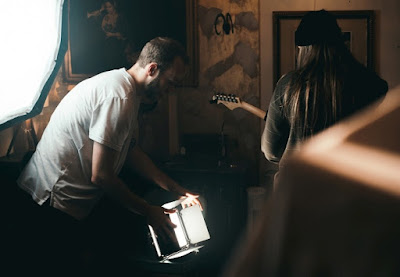Different Illumination Techniques and When to Use Them
Umbrellas
and softboxes are two commonly used light modifiers that are used to
produce diffused and soft artificial light. Softboxes provide direct
and controlled lighting, which is similar to sunlight coming in
through a window. On the other hand, umbrellas produce broader,
diffused lighting like outdoor light, which is uncontained and
uncontrolled.
Are
you still confused between both two? Let’s dive deep into the
comparison between Softbox vs. umbrella.
Softbox
A
softbox imitates the directional, soft lighting, which is usually
generated by window light. It diffuses and softens the lighting from
the attached source of light by transmitting it through the diffusion
panel. It is available in different shapes such as rectangular,
square, or octagonal shapes and sizes like large ones that produce
very soft, directional light when placed closer to the subject.
With
this lighting, as you are shooting through instead of relying on the
reflected light, your flash needs lesser power to get a similar lens
aperture. To find the best budget lighting, visit deanosborne.com.
Umbrella
The
umbrella is an accessible light modifier because it is less
expensive, highly portable, and simple to use. Umbrellas provide soft
and broad light to photographers, which emulates outdoor lighting.
Unlike softboxes, it generates unrestricted lighting, which will go
well everywhere. Umbrellas are available in two types; reflective
umbrellas and shoot-through umbrellas.
Reflective Umbrellas
The
interior of the umbrella is generally up made of a reflective,
metallic material, while its outside is made of an opaque material.
With this umbrella, you require to set up the inner reflective
portion that faces the object, and you can easily shoot the flash
into the reflective material so that the hard light reflects a
broader, softer, and more light into your video subject.
Shoot-through Umbrellas
 These
types of umbrellas are made using a white, plain, and
semi-translucent material. To diffuse the light with shoot-through
umbrellas, you must point the outside portion of the umbrella to your
object and shoot flash towards the opening to pass the light through
the translucent material. Thus it makes the light softer. Unlike the
reflective types of the umbrella, the light from shoot-through is
much easier to control.
These
types of umbrellas are made using a white, plain, and
semi-translucent material. To diffuse the light with shoot-through
umbrellas, you must point the outside portion of the umbrella to your
object and shoot flash towards the opening to pass the light through
the translucent material. Thus it makes the light softer. Unlike the
reflective types of the umbrella, the light from shoot-through is
much easier to control.
Umbrella
generate bounced, indirect light that may need a flash with more
output from the light source. As umbrellas provide broader, diffused
lighting types, it is simple to use for beginners. Point an umbrella
to the subject of your video, and you can straightaway get soft
lighting.
Unlike
umbrellas, softboxes will require you to have some basic knowledge of
balancing the fill vs. key light (fill can be generated through an
umbrella or any reflector). Hence, softboxes can’t be used to
produce highly contrasting lighting. Softboxes are more complicated
to set up and use the umbrellas. Read the detailed difference between
the two lighting sources and understand how to choose the right for
you: A
Guide to Choosing Umbrellas and Softboxes.
Choosing
the right light modifier that exactly matches the type of portrait
that you attempt to create will enhance the looks of your video.
Sometimes, it will need an umbrella, and other times you may need to
use a Lightbank. To understand the lighting requirements for your
video, you can read: Affordable Lighting for YouTube Videos: The Ultimate Guide.
There
is no standard solution for every situation. You will need to choose
the right ISO and lens if you want a natural light picture when it
comes to operating artificial light, you may have to select the
perfect tools for your video shoot.



Comments
Post a Comment